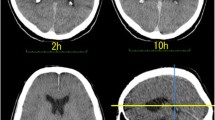Abstract
Introduction
Putrefaction of the brain is a challenge to a forensic pathologist because it may lead to considerable organ alterations and restrict documenting reliable autopsy findings.
Objectives
This study aims to present a new and systematic evaluation of possible benefits of post-mortem MR Neuroimaging (1.5 Tesla, sequences: T1w, T2w) in putrefied corpses in comparison to PMCT and autopsy.
Methods
A post-mortem MRI brain examination was conducted on 35 adult, putrefied corpses after performing a whole body CT scan prior to a forensic autopsy. Imaging data and autopsy findings were compared with regard to brain symmetry, gray and white matter junction, ventricular system, basal ganglia, cerebellum, brain stem, and possible pathological findings.
Results
At autopsy, a reliable assessment of the anatomical brain structures was often restricted. MR imaging offered an assessment of the anatomical brain structures, even at advanced stages of putrefaction. In two cases, MR imaging revealed pathological findings that were detectable neither by CT scans nor at autopsy.
Conclusions
Post-mortem MR imaging of putrefied brains offers the possibility to assess brain morphology, even if the brain is liquefied. Post-mortem MR imaging of the brain should be considered if the assessment of a putrefied brain is crucial to the evaluation of a forensic autopsy case.



Similar content being viewed by others
Abbreviations
- MRI:
-
Magnetic resonance imaging
- PMMRI:
-
Post-mortem magnetic resonance imaging
- PMCT:
-
Post-mortem computed tomography
- PMI:
-
Post-mortem interval
- RAI:
-
Radiological alteration index
- T:
-
Tesla
- T2w:
-
T2-weighted
- T1w:
-
T1-weighted
- TR:
-
Repetition time
- TE:
-
Echo time
References
Levy AD, Harcke HT, Mallak CT (2010) Postmortem imaging: MDCT features of postmortem change and decomposition. Am J Forensic Med Pathol 31(1):12–7
Jackowski C et al (2006) Postmortem unenhanced magnetic resonance imaging of myocardial infarction in correlation to histological infarction age characterization. Eur Heart J 27(20):2459–67
Zech WD et al (2015) Postmortem MR quantification of the heart for characterization and differentiation of ischaemic myocardial lesions. Eur Radiol 25(7):2067–73
Michaud K et al (2014) Postmortem imaging of sudden cardiac death. Int J Legal Med 128(1):127–37
Langlois NE, Ross CG, Byard RW (2013) Magnetic resonance imaging (MRI) of bruises: a pilot study. Forensic Sci Med Pathol 9(3):363–6
Christe A et al (2010) Clinical radiology and postmortem imaging (Virtopsy) are not the same: specific and unspecific postmortem signs. Leg Med (Tokyo) 12(5):215–22
Ampanozi G et al (2010) Virtopsy: CT and MR imaging of a fatal head injury caused by a hatchet: a case report. Leg Med (Tokyo) 12(5):238–41
Thali MJ et al (2003) Image-guided virtual autopsy findings of gunshot victims performed with multi-slice computed tomography and magnetic resonance imaging and subsequent correlation between radiology and autopsy findings. Forensic Sci Int 138(1–3):8–16
Ellis TS et al (2000) Acute identification of cranial burst fracture: comparison between CT and MR imaging findings. AJNR Am J Neuroradiol 21(4):795–801
Wallace SK et al (1994) Judicial hanging: postmortem radiographic, CT, and MR imaging features with autopsy confirmation. Radiology 193(1):263–7
Yen K et al (2005) Postmortem multislice computed tomography and magnetic resonance imaging of odontoid fractures, atlantoaxial distractions and ascending medullary edema. Int J Legal Med 119(3):129–36
Kobayashi T et al (2010) Characteristic signal intensity changes on postmortem magnetic resonance imaging of the brain. Jpn J Radiol 28(1):8–14
Scheurer E et al (2011) Forensic application of postmortem diffusion-weighted and diffusion tensor MR imaging of the human brain in situ. AJNR Am J Neuroradiol 32(8):1518–24
Schmierer K et al (2008) Quantitative magnetic resonance of postmortem multiple sclerosis brain before and after fixation. Magn Reson Med 59(2):268–77
Jackowski C et al (2005) Adipocere in postmortem imaging using multislice computed tomography (MSCT) and magnetic resonance imaging (MRI). Am J Forensic Med Pathol 26(4):360–4
Yen K et al (2007) Post-mortem forensic neuroimaging: correlation of MSCT and MRI findings with autopsy results. Forensic Sci Int 173(1):21–35
Ruder TD, Thali MJ, Hatch GM (2014) Essentials of forensic post-mortem MR imaging in adults. Br J Radiol 87(1036):20130567
Egger C et al (2012) Development and validation of a postmortem radiological alteration index: the RA-Index. Int J Legal Med 126(4):559–66
Zech WD et al (2014) Characterization and differentiation of body fluids, putrefaction fluid, and blood using Hounsfield unit in postmortem CT. Int J Legal Med 128(5):795–802
Aghayev E et al (2004) Virtopsy post-mortem multi-slice computed tomography (MSCT) and magnetic resonance imaging (MRI) demonstrating descending tonsillar herniation: comparison to clinical studies. Neuroradiology 46(7):559–64
Jones NR et al (1998) Correlation of postmortem MRI and CT appearances with neuropathology in brain trauma: a comparison of two methods. J Clin Neurosci 5(1):73–9
Yen K et al (2006) Line-scan diffusion tensor imaging of the posttraumatic brain stem: changes with neuropathologic correlation. AJNR Am J Neuroradiol 27(1):70–3
Acknowledgments
The authors would like to thank the team of forensic pathologists and forensic autopsy technicians at our institute for their support in case handling.
Author information
Authors and Affiliations
Corresponding author
Rights and permissions
About this article
Cite this article
Tschui, J., Jackowski, C., Schwendener, N. et al. Post-mortem CT and MR brain imaging of putrefied corpses. Int J Legal Med 130, 1061–1068 (2016). https://doi.org/10.1007/s00414-016-1385-5
Received:
Accepted:
Published:
Issue Date:
DOI: https://doi.org/10.1007/s00414-016-1385-5




